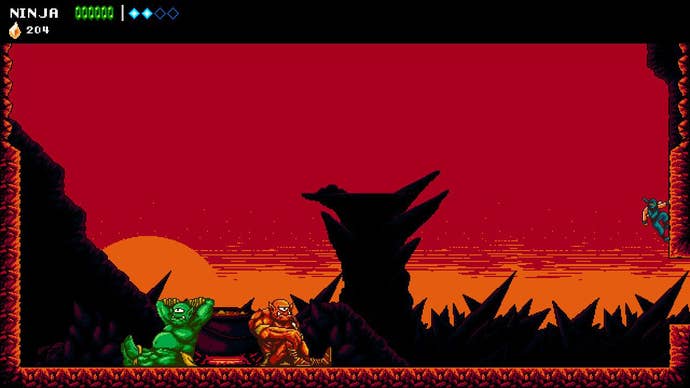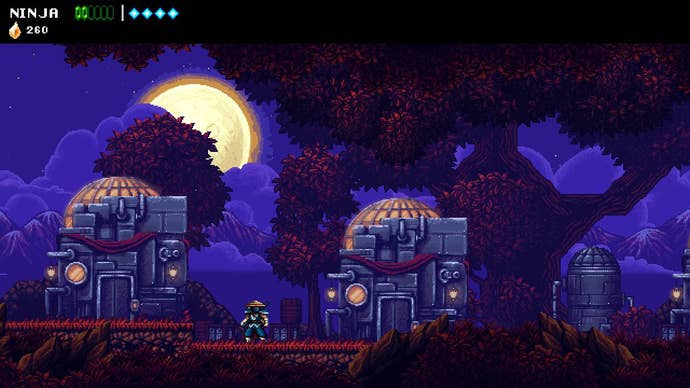The Messenger Review
The best retro tribute since Shovel Knight.
This article first appeared on USgamer, a partner publication of VG247. Some content, such as this article, has been migrated to VG247 for posterity after USgamer's closure - but it has not been edited or further vetted by the VG247 team.
You can always tell when a retro tribute is more than just a cynical cash-in. The graphics are always that much sharper, the soundtrack that much better, the cuts that much deeper. To this point, Shovel Knight has been the gold standard for modern retro platformers, driven as it is by its creators' pure passion for classic gaming. But now it has some company: The Messenger, the latest indie from Devolver Digital on Nintendo Switch.
The Messenger is a stunning tribute to 8-bit platforming, 16-bit metroidvanias, and retro gaming as a whole. It is an exquisitely designed platformer full of wonderful surprises, and it has an unbelievable soundtrack to boot. It follows a hapless ninja student who ends up earning the eponymous title after their village is destroyed by a demon, and subsequently sets off into the world to deliver a mysterious scroll. One part Shinobi, one part Ninja Gaiden, and one part Shovel Knight, The Messenger is initially a fairly straightforward 8-bit platformer, albeit an extremely enjoyable one. Being a retro platformer, the story is slim at best, focusing in large part on humorous observations and breaking the fourth wall. It plays around a bit with time travel, and there's one genuinely wonderful scene involving a mysterious cabinet that you can't open for the better of the game, but otherwise it's largely relegated to the background. The gameplay is very much the focus of The Messenger.
It begins with the idea of being able to do an air jump after striking an enemy, then progressively builds in wall climbing, a wingsuit, and a grappling hook, all of which must be used to negotiate a series of increasingly gnarly obstacles. The grappling hook deserves special mention, because it figures heavily into many of The Messenger's more elaborate courses. Capable of attaching to hooks and walls, it provides a crucial burst of momentum for crossing large gaps. It's equally useful against bosses, as it can be used to pass through an enemy as they charge at you, lending the action the feel of a samurai duel.
The result is one of the smoothest and most enjoyable platforming experiences I've ever had. Once you get the hang of the controls, you'll find yourself fairly gliding through an increasingly difficult series of enemies, projectiles, spikes, and collapsing ceilings. It's consistently challenging without being overly frustrating: a difficult needle to thread, but one which The Messenger negotiates masterfully.
The quality of the level design is matched by the soundtrack and the art. The music is supremely good, matching even the memorable Shovel Knight with energetic 8-bit chiptunes that push you through every level. The comparatively small sprites, which initially seem a bit simple, are augmented with wonderful little animated flourishes, and later contrasts nicely with some massive and detailed bosses.
It's all so good, with each level topping the last, my only real quibble—or Quarble, if you prefer—being with its death penalty system. The Messenger uses a fairly standard checkpoint system, the catch being that death results in you being followed by a little red demon called Quarble, which sucks up your hard-earned gems as you collect them. It's not a particularly steep death penalty, but it is a needling reminder that you made a mistake, as Quarble will taunt you with your death count and other unfortunate statistics while you reload. It's meant to be amusing, but it's mostly irritating, and there doesn't seem to be much point to it save as a mark of shame for speedrunners who screw up. In any case, Quarble doesn't really hurt the overall game, but it could easily be excised without anyone really noticing or caring.
If what I described above was all that The Messenger had to offer, it would be a very enjoyable little game. But it goes much further than that.

[Note: At this point I'm going to start talking about the neat twists that follow the initial run of levels. If you don't want to be spoiled on them, I suggest you stop reading here. Just know that The Messenger is awesome and I completely recommend it.]
After several levels, you are catapulted into the future, which is rendered as a beautiful 16-bit platformer, right down its use of the exact same instruments found in the Sega Genesis sound chip. For as often as developers lean on nostalgia to peddle their wares, 16-big nostalgia is still comparatively rare, as the more detailed sprites take a lot more effort to render. The Messenger shifts between the two styles almost effortlessly, at one point introducing little 8-bit "bubbles" in the 16-bit future, where even the soundtrack swaps in and out. It's an outstanding achievement in artistic design made that much more impressive by the fact that it nails the look of a 16-bit platformer circa 1990. The only concession it makes is to the color palette—it's far brighter and more exciting than any Genesis game of that period. And frankly, I'm fine with that.
After spending a couple levels in the 16-bit future, The Messenger ups the ante still further, and seamlessly morphs into a metroidvania. This is where it goes from an amazing tribute to potential classic for me. Lesser games would probably just feature remixed versions of older levels, only with a 16-bit palette; and in all honestly, that would probably be fine. But The Messenger stitches them all together, creating a whole new game in the process. It's a breathtaking transition that The Messenger carries off effortlessly.
Unlike most games of its type, The Messenger's exploration sections aren't dedicated to finding new abilities, since you unlock pretty much all of them in the platforming section. Instead, it's about exploring freely, finding connections to other areas, and deciphering the cryptic clues given to you by the robed keepers of the Tower of Time. Notably, The Messenger's excellent platforming mechanics remain intact throughout, ensuring that the exploration never feels rote or boring.

The final twist is the way in which The Messenger effortlessly mixes its 8 and 16-bit worlds. You'll be exploring an area and see a bubble in time, and then suddenly you'll be flashed back to an 8-bit version of the same area, with the soundtrack shifting to match. Flipping between the 8 and 16-bit worlds is crucial for removing certain obstacles, allowing you to continue freely into the next area.
It's such a cool way to express the exploration. In mashing up what amounts to two entirely different games, The Messenger risks devolving into an incoherent and unsatisfying mess. Instead, it's a special and memorable experience both for retro enthusiasts and indie fans alike.
It's been a tremendous year for metroidvanias and platformers alike, particularly on the Switch, and it's not easy to stand out in this crowded year. The indie explosion has brought with it many gems, but also a lot of debris. And unfortunately, many of the worst games look superficially like The Messenger.
Thankfully, I can confidently say that The Messenger is the real deal. It's the most polished, thoughtful, and accurate tribute to retro gaming that I've seen in a very long time. I recommend it wholeheartedly.
ConclusionThe Messenger establishes itself as an excellent tribute to old-school platformers, then proceeds to rapidly up the ante with a series of outstanding gameplay twists. I'm deeply impressed by The Messenger's ambition and polish. It's a must-own for any retro enthusiast.




